
The Buryats are a Mongolic ethnic group native to southeastern Siberia who speak the Buryat language. They are one of the two largest indigenous groups in Siberia, the other being the Yakuts. The majority of the Buryats today live in their titular homeland, the Republic of Buryatia, a federal subject of Russia which sprawls along the southern coast and partially straddles Lake Baikal. Smaller groups of Buryats also inhabit Ust-Orda Buryat Okrug and the Agin-Buryat Okrug which are to the west and east of Buryatia respectively as well as northeastern Mongolia and Inner Mongolia, China. They traditionally formed the major northern subgroup of the Mongols.

Ulan-Ude is the capital city of Buryatia, Russia, located about 100 kilometers (62 mi) southeast of Lake Baikal on the Uda River at its confluence with the Selenga. According to the 2021 Census, 437,565 people lived in Ulan-Ude; up from 404,426 recorded in the 2010 Census, making the city the third-largest in the Russian Far East by population.

Buryatia, officially the Republic of Buryatia, is a republic of Russia located in the Russian Far East. Formerly part of the Siberian Federal District, it has been administered as part of the Far Eastern Federal District since 2018. It borders Irkutsk Oblast and Lake Baikal, the deepest lake in the world to the north, Zabaykalsky Krai to the east, Tuva to the west and Mongolia to the south. Its capital is the city of Ulan-Ude. It has an area of 351,300 square kilometers (135,600 sq mi) with a population of 978,588. It is home to the indigenous Buryats.

Kyakhta is a town and the administrative center of Kyakhtinsky District in the Republic of Buryatia, Russia, located on the Kyakhta River near the Mongolia–Russia border. The town stands directly opposite the Mongolian border town of Altanbulag. Population: 20,041 (2010 Census); 18,391 (2002 Census); 18,307 (1989 Census). From 1727 it was the border crossing for the Kyakhta trade between Russia and China.
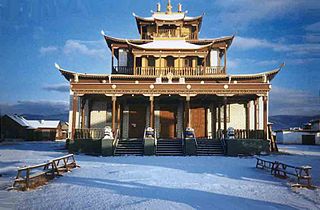
Datsan is the term used for Buddhist university monasteries in the Tibetan tradition of Gelukpa located throughout Mongolia, Tibet and Siberia. As a rule, in a datsan there are two departments—philosophical and medical. Sometimes a department of tantric practices is added to them where the monks study only after finishing education in the philosophical department.
Education in Siberia expanded greatly after the Trans-Siberian Railway was completed in the 19th century. While Siberia became part of Russia in the 17th century it was not until the 20th century under the Soviet Union that education was transformed which in turn brought Siberia to economic importance. This was aimed at uniting people under the Soviet. For example, the Irkutsk State Linguistic University served as "a conduit between Russia and these native people by teaching languages" during the communist era. Imperial Russia began uniting Siberia to Russia by founding Siberia's first university, Tomsk State University, in 1878.
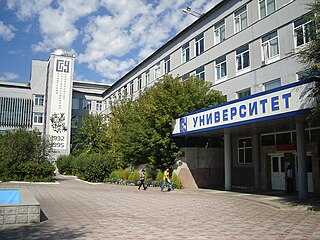
Buryat State University is an institution of higher education in Siberia and the Russian Far East, located in the city of Ulan-Ude, Buryat Republic, Russia. Courses are taught in Russian and Buryat. It was established in 1932 as the Buryat State Teachers' Training College, and became a university in 1995. It is a member of the University of the Arctic.

The Belarusian State Academy of Arts is a state-owned institution of higher education in Minsk, Belarus. The Belarusian State Academy of Arts has status as a leading institution of the national system of art and cultural education alongside the Belarusian State Academy of Music and the Belarusian State University of Culture and Arts.

Kurumkan is a rural locality and the administrative center of Kurumkansky District of the Republic of Buryatia, Russia, located 413 kilometers (257 mi) from Ulan-Ude. Population: 5,465 (2010 Census); 5,957 (2002 Census); 6,687 (1989 Census).

East Siberia State University of Technology and Management is a regional university located in Ulan-Ude, Buryatia in Russian Federation. On June, 19th, 1962 the Minister of the higher and specialized secondary education of the Russian Soviet Federative Socialist Republic (RSFSR) ordered to organize East Siberian Institute of Technology on the former basis of the technological and building faculties of Buryat Agricultural Institute of the Ministry of Agriculture of the RSFSR. In 1994 the research institute, ESIT, was given the status of the State Technological University.

Buddhism in Buryatia, a region in Siberia, Russia, has a deep-rooted history dating back to the 17th century when Tibetan Buddhism first arrived in the area. Initially adopted by ethnic groups like the Selenga and Zede Buryats, Buddhism gradually spread throughout the Transbaikal region. In 1741, it gained formal recognition as an official religion in the Russian Empire, with the establishment of Buddhist monastic universities known as datsans. Despite facing significant challenges during the Soviet era, including persecution and the closure of religious institutions, Buddhism in Buryatia has persisted and experienced a revival in the post-Soviet period.

The Republic of Buryatia is a federal subject of Russia which, according to the IMF, was an emerging economy in 2011.
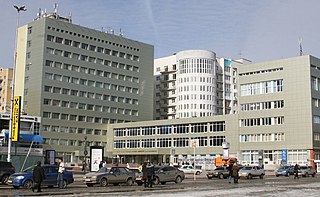
Saratov State University of Genetics, Biotechnology and Engineering named after N.I. Vavilov (Russian: Саратовский государственный университет генетики, биотехнологии и инженерии имени Н. И. Вавилова is an agricultural higher education institution in the Volga region.

Damba Badmaevich Ayusheev —the XXIV Pandito Khambo Lama—a Head of the Buddhist Traditional Sangkha of Russia.
Anarchism in Mongolia was present during the revolutionary period of the 1910s and 1920s, closely linked with the Russian anarchist movement in Altai, Buryatia and Tuva.

Chuvash State Agrarian University is a higher educational institution located in the central part of the city of Cheboksary. The full name of the university since April 2020 is the Federal State Budgetary Educational Institution of Higher Education "Chuvash State Agrarian University".
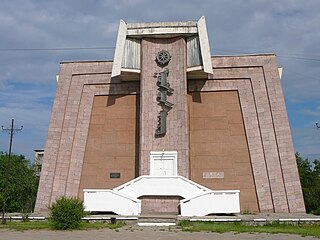
Institute for Mongolian, Buddhist and Tibetan Studies of the Siberian Branch of the Russian Academy of Sciences is a public research institution in Ulan-Ude, Russia, and a constituent institution for oriental studies under the Buryat Science Centre of the Russian Academy of Sciences. It was founded on July 1, 1922 as the Buryat Scholarly Committee under the leadership of Bazar Baradin, with the objective of studying history, language, and culture of Buryatia. In 1949, it entered the Siberian Branch of the Academy of Sciences of the USSR under the name of Buryat-Mongolian Scientific and Research Institute of Culture.

Nikolai Buduyev is a Russian political figure, deputy of the 7th and 8th State Dumas. In 1996 he graduated from the Buryat State University. In 1998, he was hired as a consultant to the Committee on Public Information of the Presidential Administration and the Government of the Republic of Buryatia. In 2006, he became an assistant to Vasily Kuznetsov who was at that time the deputy of the State Duma of the 4th convocation. In 2010, he was appointed head of the information and analytical center of the administration of Ulan-Ude. In 2012 he became the director of the only publishing house in Buryatia that publishes Moskovskij Komsomolets, the major news outlet in the region. He was also assigned an editor chief of the newspaper
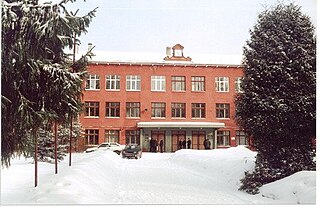
The Yaroslavl State Agricultural Academy is a public high educational institution in Yaroslavl, Russia. It trains specialists for agricultural industry, as well as dog handlers, veterinarians, and landscape designers.
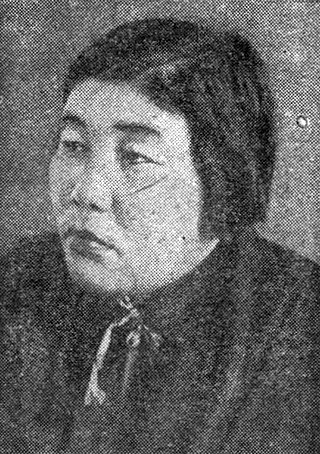
Gunsyn Ayusheevna Tsydenova was a Soviet veterinarian and politician who served as the chairman of the Presidium of the Supreme Soviet of the Buryat-Mongol Autonomous Soviet Socialist Republic from 1941 until 1947, leading the ASSR through World War II. Tsydenova also served a deputy of the Supreme Soviet of the Soviet Union from 1937 until 1954.





















